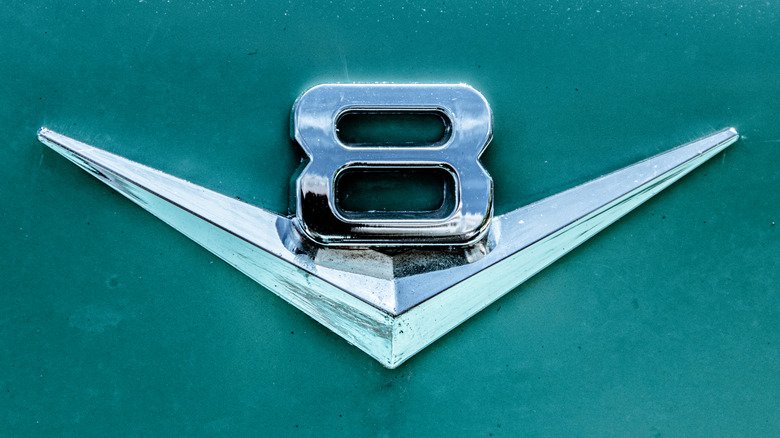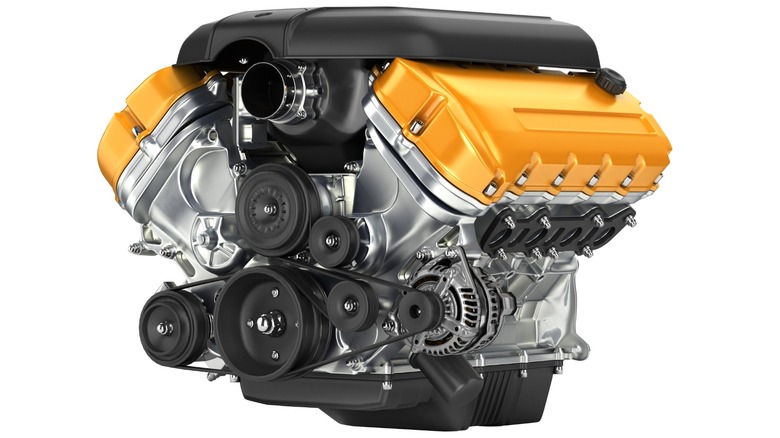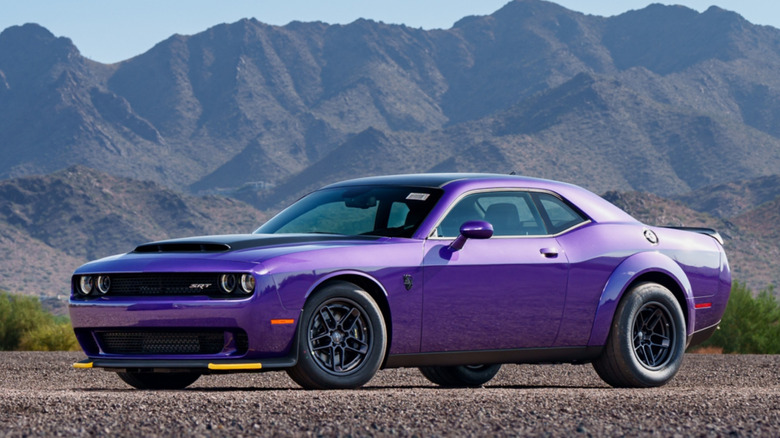How The Most Popular Car Engine In History Actually Works
You don't need to be a gearhead to know the name, V8. It's not just the most famous automobile engine ever created; it's an emblem of Americana, celebrated in pop culture in rock and roll hits like the Beach Boys' "409" and Paul Revere and the Raiders' "SS 396," and in movies like "Mad Max" and the "Cars" franchise. For such a specific piece of machinery to receive such notoriety is a rare feat, but the V8 is something truly special.
The V8 is a type of piston engine used primarily in high-performance vehicles like sports cars, muscle cars, and trucks. A piston engine works in four stages, known as the four strokes. First is the intake stroke, in which the piston moves down, taking in fuel and air. The second stroke is compression, where the piston moves upwards, compressing the air and fuel it just took in. The third stroke is the power stroke, in which the piston hits a spark plug that ignites the fuel and generates power (this is the stroke that actually makes the vehicle move). The fourth and final stroke, the exhaust stroke, pushes out the byproduct left behind from combustion.
The V8 engine gets its name because it features eight piston cylinders, arranged in two banks of four that are joined at a 90 degree angle to create a V formation. Most car engines only have four cylinders, which fire one-at-a-time, but a V8 doubles that, with cylinders firing in pairs to provide a smoother continuous power output.
The secrets behind the V8's power
When French inventor Leon Levavasseur created the first V8 engine in 1902, he was aiming for something so powerful, it wasn't even meant for cars. Levavasseur built the engine for speedboats and aircraft, and it was only after automotive companies like Rolls Royce and Cadillac caught wind of the V8 that its incredible horsepower found its way into cars. Most car engines only have four cylinders, which fire one-at-a-time, but a V8 doubles that, with cylinders firing in pairs.
More cylinders means more power because of something called displacement. Displacement refers to the amount of space within an engine, which determines the volume of fuel and air that it can process. A V8 has greater displacement than the more common four or six cylinder engines, allowing it to produce more power. The arrangement of the cylinders also matters. In the 1920s, several cars were made with straight-eight engines, where eight cylinders were arranged in one row. However, they were incredibly bulky and they vibrated so much that they'd often break down. Separating the eight cylinders into two rows of four saves space, and the V structure provides stability.
The biggest breakthrough for V8 engines came in 1932, when the Ford Motor Company debuted its version, which was designed in partnership with famed inventor Thomas Edison. The Ford flathead V8, as it was called, was revolutionary because it was cast in a single piece, allowing it to become the first mass-produced V8. Its debut launched America's hot rod culture.
Can the V8 adapt to an uncertain future?
Gasoline-powered vehicles are among the leading causes of greenhouse gas emissions, which in turn have driven climate change. Concerns about anthropogenic global warming first arose around in the mid-20th century, and in 1970, the United States government passed the Clean Air Act to regulate pollutants in the air. These regulations set off a period of decline for the V8 engine as automobile manufacturers struggled to adapt their technologies. The only way to make V8 engines adhere to new smog standards was to significantly reduce their power output. This is exemplified by Chevrolet, which went from producing V8 engines with 450 horsepower in 1970 to just 180 horsepower in their 1977 V8s. However, the saga wasn't over just then.
The V8s of the mid-1900s were incredibly inefficient, with up to 80% of the fuel energy being lost to friction, waste heat, and entropy, but since the 1990s, the V8 has seen a resurgence with innovations to improve fuel efficiency and reduce emissions overall. At the same time, the engines have become more powerful than ever before, eclipsing 1,000 horsepower.
Perhaps the boldest iteration of the V8 engine to date is the 2023 Hellcat V8 produced by Dodge, an update in the famous line of Hemi V8s. It runs on E85 fuel, which is an alternative fuel made with ethanol derived from corn, sugarcane, and wood-processing waste. While running on a cleaner fuel source, it still puts out a stunning 1,025 horsepower.


